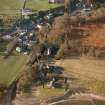Pricing Change
New pricing for orders of material from this site will come into place shortly. Charges for supply of digital images, digitisation on demand, prints and licensing will be altered.
Golspie, Main Street, St Andrew's Parish Church
Chapel (14th Century), Church (18th Century)
Site Name Golspie, Main Street, St Andrew's Parish Church
Classification Chapel (14th Century), Church (18th Century)
Alternative Name(s) Golspie, St Andrew's Church
Canmore ID 6591
Site Number NC80SW 6
NGR NC 83775 00225
Datum OSGB36 - NGR
Permalink http://canmore.org.uk/site/6591
First 100 images shown. See the Collections panel (below) for a link to all digital images.
- Council Highland
- Parish Golspie
- Former Region Highland
- Former District Sutherland
- Former County Sutherland
NC80SW 6.00 83775 00225
NC80SW 6.01 NC 8377 0023 Gordons of Carroll burial-enclosure
NC80SW 6.02 NC 83775 00212 Burial Ground
See also NC80SW 13.
(NC 8377 0023) Church (NAT) on site of Church (NR)
OS 6" map, (1969)
The 18th century parish church stands on the site of St Andrew's Chapel. St Andrew's Chapel is on record in 1330 and was in use until at least 1556. In 1619 the parish church was transferred from Kilmaly (NH79NE 5) to this site. The present church was built in 1738 and had an aisle added in 1751, but it may embody parts of a simpler building extant in 1650. (See also NC80SW 13.)
R Gordon 1813; Orig Paroch Scot 1855.
No further information.
Visited by OS (J M) 29 October 1975.
ARCHITECT: Kenneth Sutherland, joiner 1738
Mr George Hay states that he has recorded this to some extent.
Publication Account (1996)
The church with its pleasant white-harled exterior and neat belfry stands on a knoll above the street. The site may be early, for a Pictish cross-slab stood here (now in Dunrobin Museum). There was a 'chapell of Sanct Andrew' at Golspie from at least the 14th century, and in 1619 this became the parish church. Whether the old chapel was used as such or a new church built is not known. By the mid-18th century the church had become unsafe; 'both the gavils (gables) were broke off from the side walls' and it was all pulled down and rebuilt in 1736-7 on a T-plan, with the main east-west block probably set on the old foundations. The new north aisle faced the pulpit on the south wall, and housed the handsome Sutherland loft. The church was also provided with fixed seating at this time, and the communion table pews opposite the pulpit may be of this date. The south wall soon became unsafe again, and the south aisle was added to prop it up in 1751.The east and west lofts were originally rather simple, and the present stepped lofts were only made about 1849. Most of the pews were replaced in 1954 but resemble the originals.
The pulpit with its carved backboard and canopy is dated 1738 and the Sutherland loft 1739. The loft has panelled walls, and three slender columns support its carved entablature with painted details, including the Sutherland coat of arms. Behind the loft was a comfortable retiring room with a fireplace, reached by an outside stone stair. Here the Sutherland family could retire to eat a meal between the morning and afternoon services.
The interior of the church is an admirable example of the layout and furnishings of an 18th-century kirk. Only in the south aisle have there been changes, where an organ and seats for the choir have replaced the elders' pew, the precentor's desk and the stool of repentance.
Information from ‘Exploring Scotland’s Heritage: The Highlands’, (1995).
Watching Brief (21 February 2022 - 29 March 2022)
NC 83740 00200 A watching brief was carried out during groundworks associated with the construction of a new pedestrian access ramp at St Andrew’s Church, Golspie. The watching brief was carried out intermittently between 21 February and 29 March 2022.
The groundworks uncovered several services and associated mixed backfill material. No archaeological features or deposits were identified. No further archaeological work is recommended.
Archive: NRHE (intended) Funder: Church of Scotland
Callum Murray – AOC Archaeology Group
(Source: DES Volume 23)














































































































































































































